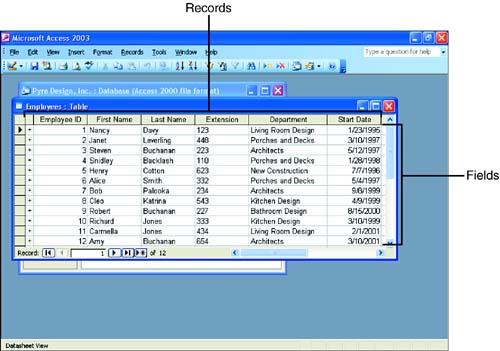Understanding Access Databases and Objects
| Strictly speaking, a database is any collection of information. Your local telephone book, for example, is a database, as is your Contacts folder in Outlook. Microsoft Access makes creating databases very straightforward and relatively simple. The electronic container that Access provides for holding your data is called a table (see Figure 1.2). Figure 1.2. A table serves as the container for your database information. A table consists of rows and columns . Access stores each database entry (for example, each employee or each inventory item) in its own row; this is a record . Each record contains specific information related to one person, place, or thing.
Each record is broken up into discrete pieces of information, called fields. Each field consists of a separate column in the table. Each field contains a different piece of information and all the fields in one row make up a particular record. For example, Last Name is a field. All the last names in the entire table (all in the same column) are the data that is held in the Last Name field of each record.
Access is a special kind of database called a relational database . A relational database divides information into discrete subsets. Each subset groups information by a particular theme, such as customer information, sales orders, or product information. In Access, these subsets of data reside in individual tables like the one described previously. Access enables you to build relationships between tables. These relationships are based on a field that is common to two tables. Each table must have a field called the primary key (you learn how to specify a field as the primary key in Lessons 3 and 4). The primary key must uniquely identify each record in the table. So, the primary key field is typically a field that assigns a unique number (no duplicates within that table) to each record. For example, a Customers table might contain a Customer Identification field (shown as Customer ID in Figure 1.3) that identifies each customer by a unique number (such as your Social Security number). You might also have a table that holds all your customer orders. To link the Orders table to the Customers table, you include the Customer Identification field in the Order table. This identifies each order by customer and links the Order table data to the Customers table data. Figure 1.3. A relational database contains related tables.
You will find that even a simple database consists of several tables that are related. Figure 1.3 shows a database and the different table relationships. Lesson 9, "Creating Relationships Between Tables," provides information on creating table relationships. The table is just one type of object found in Access. There are several more with which you can work, including forms, queries, and reports .
In essence, each of these different database objects gives you a different way of viewing and manipulating the data found in your tables. Each of these objects (including the table) should also be considered as you plan a new database. |
EAN: N/A
Pages: 660
- Key #1: Delight Your Customers with Speed and Quality
- Key #2: Improve Your Processes
- Making Improvements That Last: An Illustrated Guide to DMAIC and the Lean Six Sigma Toolkit
- The Experience of Making Improvements: What Its Like to Work on Lean Six Sigma Projects
- Six Things Managers Must Do: How to Support Lean Six Sigma

